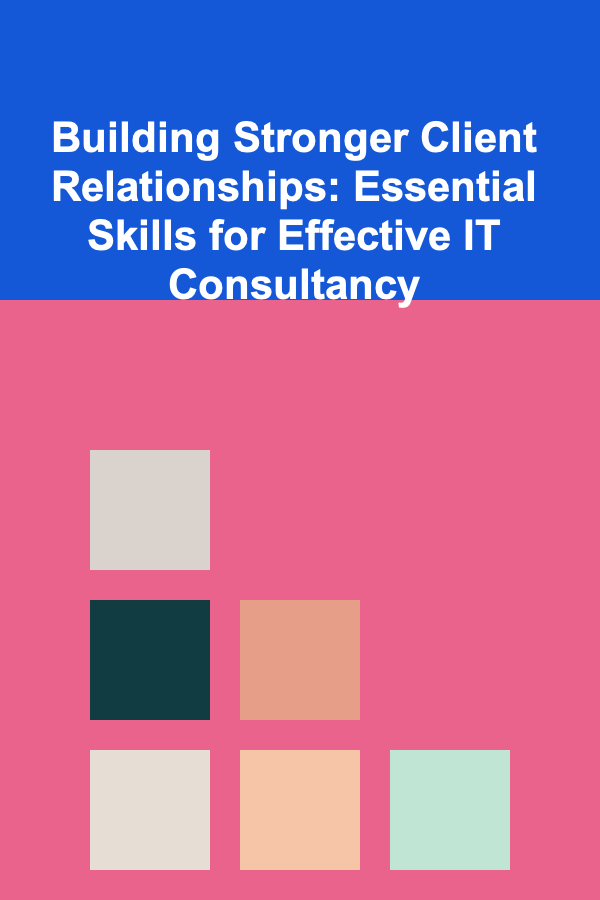
Building Stronger Client Relationships: Essential Skills for Effective IT Consultancy
ebook include PDF & Audio bundle (Micro Guide)
$12.99$7.99
Limited Time Offer! Order within the next:

In the fast-evolving world of IT consulting, technical expertise is crucial. However, what truly sets exceptional consultants apart is their ability to foster and maintain strong client relationships. After all, consulting is not just about offering technical solutions---it's about understanding your client's needs, solving their problems, and building a partnership that benefits both parties in the long term.
Strong client relationships form the foundation of a successful consulting career, ensuring repeat business, referrals, and long-term success. But how do you go about building and nurturing these relationships? This guide will dive deep into the essential skills and strategies that can help you strengthen client relationships and elevate your IT consultancy business.
Active Listening and Empathy
The first and perhaps most important skill for building strong client relationships is active listening. In IT consultancy, this is more than just hearing your client's words---it's about truly understanding their challenges, objectives, and pain points. By actively listening and showing empathy, you can tailor your solutions to meet the specific needs of the client.
Actionable Steps:
- Ask open-ended questions: Instead of asking yes-or-no questions, encourage your clients to elaborate on their challenges and goals. For example, ask, "What are the main obstacles your team is facing with your current IT setup?"
- Reflect and paraphrase: After listening, reflect back what you've heard to confirm your understanding. Say things like, "So what you're saying is...", or "I understand that your team is struggling with...."
- Show empathy: Acknowledge the client's frustrations and challenges. Statements like "I can see how that would be frustrating" show that you genuinely care about their situation.
Why This Matters:
Clients want to feel heard and understood. When they see that you are genuinely interested in solving their problems and are not just pushing solutions, they are more likely to trust you and feel valued. Empathy fosters a sense of partnership, which is key to a long-term relationship.
Clear Communication and Transparency
Communication is at the heart of any successful consultancy relationship. Clear, transparent communication helps manage client expectations and ensures that both parties are aligned throughout the project. Without it, misunderstandings and conflicts can arise, jeopardizing both the relationship and the project's success.
Actionable Steps:
- Set clear expectations from the beginning: Clearly outline the project's scope, timelines, and deliverables in the initial discussions. Be upfront about any potential challenges or limitations.
- Regular updates: Keep the client informed of progress at every stage. If you encounter setbacks or delays, communicate them promptly and offer solutions or workarounds.
- Avoid jargon: While you're likely working with technical systems, your clients may not have the same level of technical expertise. Make an effort to explain things in simple, accessible terms that your client can understand.
Why This Matters:
Transparency builds trust. When clients understand the progress of their projects and feel informed every step of the way, they're more likely to stay engaged and have confidence in your ability to deliver results. Additionally, open communication helps prevent misunderstandings that could lead to dissatisfaction or project failure.
Delivering Tailored Solutions, Not One-Size-Fits-All
One of the mistakes many IT consultants make is applying a generic solution to all clients. Every business has its own unique set of challenges, goals, and requirements, and your solutions should reflect that. By customizing your services to meet the specific needs of each client, you demonstrate your commitment to helping them succeed.
Actionable Steps:
- Conduct a thorough needs assessment: Take the time to understand your client's current setup, business goals, pain points, and long-term vision. This will allow you to recommend a solution that truly addresses their specific needs, rather than offering something that's simply "good enough."
- Propose flexible solutions: Even when you recommend a solution, be open to adjustments based on the client's feedback. For instance, if a client is concerned about the implementation timeline, you might offer phased deployments or additional training to ensure a smooth transition.
- Provide strategic advice: Go beyond technical recommendations and offer strategic insights on how technology can drive business growth. Position yourself as a trusted advisor who understands both the tech and business sides of their operations.
Why This Matters:
Tailored solutions show that you value the client's unique business. It also highlights your ability to deliver value and solve problems effectively. A one-size-fits-all approach may feel impersonal or inadequate, while a custom solution fosters deeper trust and long-term collaboration.
Managing Expectations and Setting Realistic Goals
Setting realistic goals and managing client expectations are essential to building strong relationships. Many clients enter into engagements with high expectations, and it's important to balance these expectations with what is feasible in the given time and budget.
Actionable Steps:
- Define success together: Early in the relationship, have a conversation with your client about what success looks like for them. Is it achieving a specific ROI, improving operational efficiency, or increasing user adoption? Align your solutions with these objectives.
- Be upfront about challenges: If a client has unrealistic expectations, don't shy away from addressing them. It's better to manage expectations early on than to promise something you can't deliver.
- Track and report progress: Once work begins, regularly track progress against the agreed-upon goals. If any issues arise, be proactive in communicating them to the client, along with potential solutions.
Why This Matters:
Managing expectations helps prevent disappointments and misunderstandings. By working together to define success and being transparent about challenges, you ensure that both you and the client are on the same page, leading to a more productive and positive relationship.
Building Trust Through Consistency and Reliability
Trust is the cornerstone of any strong client relationship. Once trust is established, it can be incredibly difficult to rebuild if it's broken. To earn and maintain trust, you need to be consistent and reliable in your work, communication, and promises.
Actionable Steps:
- Deliver on your promises: If you say you'll deliver something by a certain date or provide a specific service, make sure you follow through. Consistently delivering on your promises builds trust and shows that you can be relied upon.
- Stay organized and efficient: Use project management tools to stay on top of deadlines, tasks, and communications. The more organized you are, the more confident your client will feel in your abilities.
- Go the extra mile: Sometimes, it's the small, unexpected gestures that build the most trust. If you notice something in your client's system that could be improved (even if it's outside the scope of your current project), let them know. Offer solutions without expecting anything in return.
Why This Matters:
Clients want to work with someone they can rely on. Reliability and consistency help build that trust and demonstrate your commitment to the project. By being someone your client can depend on, you not only strengthen the relationship but also increase your chances of securing future projects and referrals.
Being Proactive and Solution-Oriented
A key trait of great consultants is their ability to be proactive. Clients don't always know what they need until you present it to them, and they rely on your expertise to guide them. By anticipating potential issues and offering solutions before they become problems, you show that you're not just reacting to their needs---you're thinking ahead and adding value.
Actionable Steps:
- Anticipate challenges: Use your expertise to foresee potential challenges before they arise. For example, if you notice a system may be outdated soon, suggest an upgrade or replacement before it becomes a major issue.
- Offer improvements: Even if the client hasn't asked for new ideas, bring them suggestions that could make their system more efficient, secure, or cost-effective. This shows that you're invested in their success.
- Educate your clients: Sometimes the best way to be proactive is to educate your clients about new trends or technologies that could benefit their business. A well-informed client is more likely to trust your judgment and follow your recommendations.
Why This Matters:
Being proactive not only helps you solve problems before they escalate but also positions you as a trusted advisor. It builds confidence in your abilities and shows that you're invested in their success. A solution-oriented mindset helps foster collaboration and a long-term relationship.
Providing Post-Implementation Support
Client relationships don't end when the project is delivered. Offering ongoing support after the project is completed helps solidify the bond and ensures that the client feels confident in their investment. Continuous support also opens the door for future collaborations and additional services.
Actionable Steps:
- Offer training: Provide training sessions to ensure that the client's team is comfortable with the new system or technology. This will ensure the client gets the most out of their investment.
- Regular check-ins: Follow up with your client after implementation to make sure everything is running smoothly. Offer to assist with any issues that arise post-deployment.
- Be available: Provide clear avenues for clients to reach you with any questions or concerns. Whether it's through email, phone, or a ticketing system, make it easy for them to contact you if they need assistance.
Why This Matters:
Ongoing support reinforces the relationship and shows that you care about your client's success even after the project is completed. By providing continuous value, you increase the likelihood of repeat business and positive referrals.
Conclusion
Building and maintaining strong client relationships is an essential skill for effective IT consultancy. By focusing on active listening, clear communication, tailored solutions, managing expectations, consistency, and post-implementation support, you can create lasting partnerships with your clients. The more you invest in understanding your clients' needs and providing value, the more likely you are to become a trusted advisor who clients turn to for ongoing IT solutions and business growth.
Reading More From Our Other Websites
- [Hiking with Kids Tip 101] Best Ways to Incorporate Science Experiments into a Family Hike
- [Tiny Home Living Tip 101] Designing a Tiny Home for Accessibility and Aging‑in‑Place
- [Needle Felting Tip 101] Best Step‑by‑Step Guide to Needle‑Felted Seasonal Wreaths
- [Home Party Planning 101] How to Host a Successful DIY Wine Tasting Night at Home
- [Personal Care Tips 101] How to Pick the Right Hair Serum Based on Your Hair Needs
- [Personal Financial Planning 101] How to Plan Financially for an Inheritance: A Step-by-Step Guide
- [Home Storage Solution 101] How to Create a Home Library with Smart Storage Solutions
- [Tiny Home Living Tip 101] How to Transition from a Traditional House to Tiny Home Living Seamlessly
- [Home Pet Care 101] How to Provide Mental Stimulation for Your Pet at Home
- [Home Soundproofing 101] How to Soundproof a Room Without Major Renovations

How to Clean Your Oven Without Using Harsh Chemicals
Read More
How to Make Money Online as a Legal Assistant: 10 Actionable Ideas
Read More
How to Use a Zero-Based Budget for Home Expenses
Read More
How to Navigate Crypto Regulations
Read More
How to Learn a Craft from Local Artisans
Read More
10 Tips for Finding Free Camping Spots
Read MoreOther Products

How to Clean Your Oven Without Using Harsh Chemicals
Read More
How to Make Money Online as a Legal Assistant: 10 Actionable Ideas
Read More
How to Use a Zero-Based Budget for Home Expenses
Read More
How to Navigate Crypto Regulations
Read More
How to Learn a Craft from Local Artisans
Read More